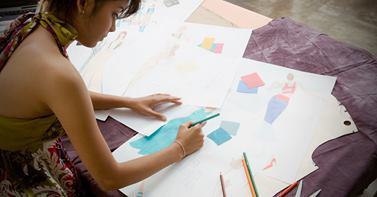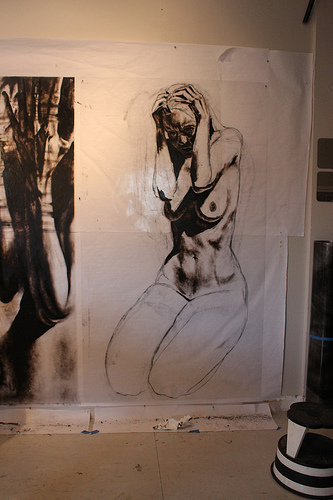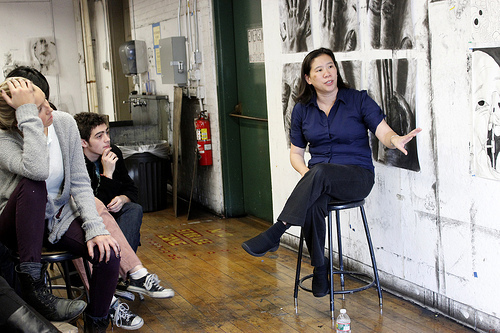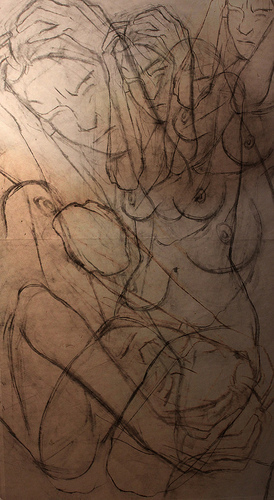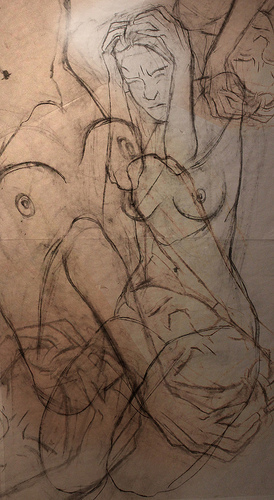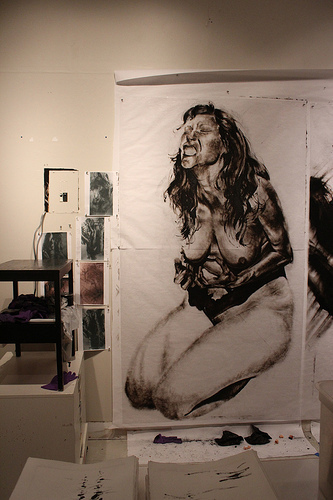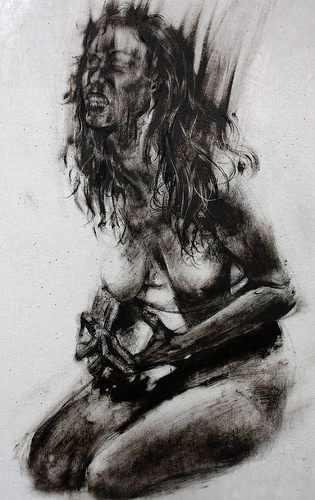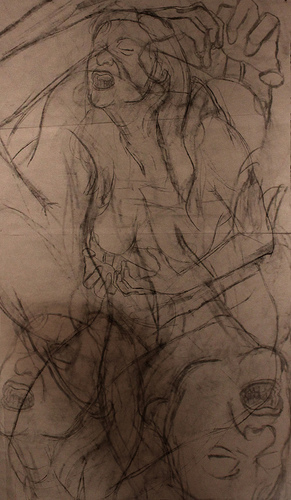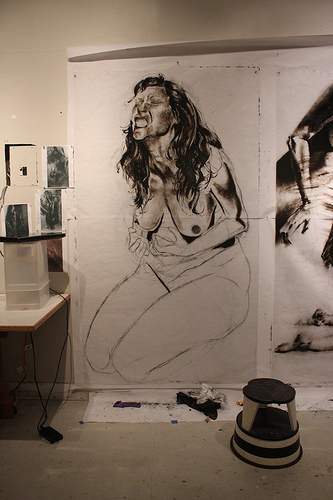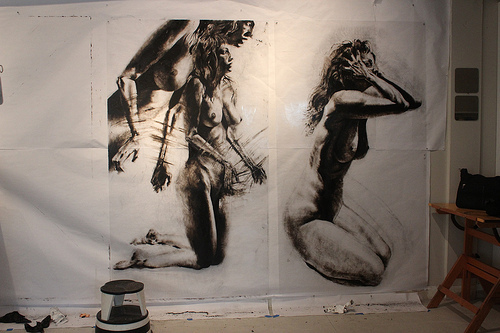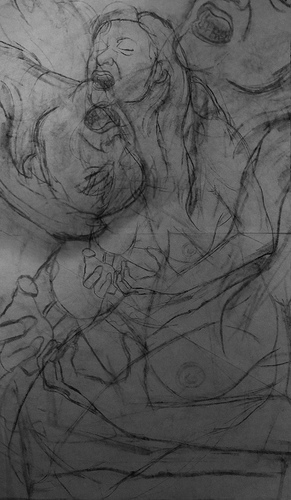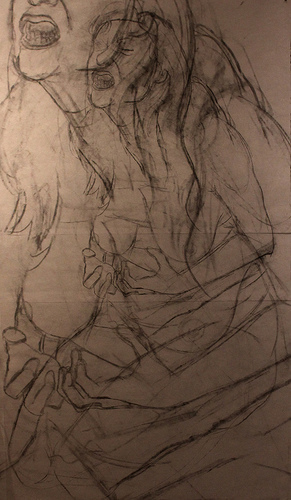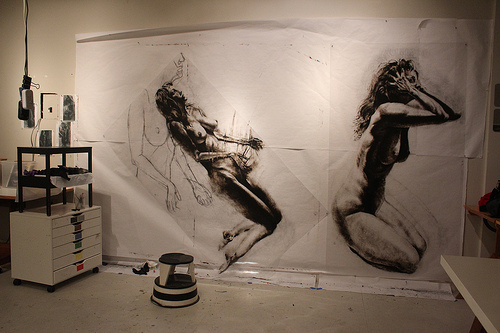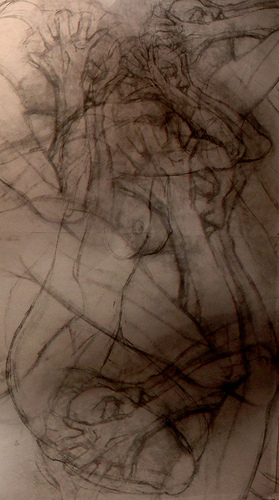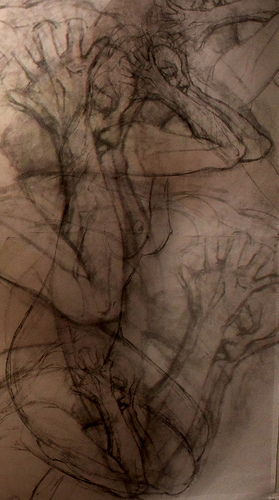Clara Lieu's Blog, page 42
October 30, 2013
Ask the Art Professor: Advice for Young Graduates
“ I just finished my BFA, where I specialized in painting and drawing, graduating in spring 2013. I am now living back in my hometown. I work at a restaurant as a dishwasher and am living back at home with my parents. I try to go to art openings in the city near where I live. I also have a small studio that I share with three other people and the rent is very affordable for me. I am in an odd point in my life though. I love painting so much and work on painting every single day. I don’t know what to do for next year. I come from a working class family and money has always been a tough issue for me. I get depressed sometimes, thinking about how expensive life is. I want to live in a cosmopolitan international city to pursue grad school. But I stress about the money all the time. What is your advice to young students who have just graduated from their undergraduate degree?”
Life immediately after art school can be traumatic. Most art students go through immense culture shock when they transition from art school into the “real world.” Going from being intensely saturated with artistic activity and other artists to almost nothing can be incredibly depressing and difficult to deal with. Feelings of isolation are common for young artists, and many find themselves at a loss for how to begin and what to do.
My greatest piece of advice is to be as proactive as humanly possible. Many young artists get caught up in what they can’t do. In doing so, they deplete their energy by focusing on the obstacles and limitations that are in the way of what they want. The problem with this approach is that you can end up convincing yourself that you are helpless with your hands tied behind your back.
The truth is, you are never helpless. Instead, focus on what you can do. Get creative with the supplies, facilities and time that’s available to you at the moment. You’ll be amazed at what you can accomplish. When I was a young graduate, I couldn’t afford a studio space, so I purchased a small, inexpensive printing press and made a series of 4″ x 5″ drypoint prints (a non-acid intaglio printmaking technique) in my apartment living room. I had a friend in graduate school who used to get some of her supplies for her sculpture from the garbage on the streets of New York City. One of my colleagues works with nothing but paper towels, cardboard and Elmer’s glue.
Once you’ve developed the circumstances to be creating your work, be sure that you never, ever stop making your art. The first year out of school, I hardly made anything. I told myself that I was too exhausted from my day job, that I had no studio space, that I couldn’t afford art supplies. I sketched in my sketchbook every once in the while, went to the occasional life drawing session, but nothing remotely substantial or even skimming the level of production I was at in art school.
So what happened? Someone gave me a sorely needed wake up call. By chance, I ran into one of my former professors who I really liked and respected tremendously. We chatted and then he asked me, “So, how is your artwork going?” I felt so ashamed to tell him that I wasn’t making anything, and ran through my list of excuses. He firmly stated, “Clara, you were one of my best students, you have to make your art.” He gave me his contact information and agreed to look at my artwork now and then. Knowing that someone was out there looking out for me got me incredibly motivated to make my work. We’ve sustained our relationship now for over 15 years, and to this day, I look forward to our regular conversations with enthusiasm.
This brings me to the next thing you can be proactive about: building your own artistic community through artist friends and mentors. As intimidating as it might seem at first, don’t be afraid to call or email one of your former professors to ask for help and advice on a regular basis. I’m so glad that I forced myself to get over that fear and contacted my former professors early on. Most professors are happy to hear from former students, and they can provide practical guidance for how to navigate life as a professional artist. They will understand better than anyone else where you are coming from and commiserate with your struggles. Even as a mid-career artist, I find conversations with my mentors to be compelling and important.
Ask the Art Professor is a weekly advice column for visual artists. Submit your questions to clara(at)claralieu.com


October 28, 2013
Clearance Sale
I’ve been frustrated by how long the etching ink has been taking to dry. I suspect that it’s the anti-skin spray that I used on the etching ink. Anti-skin spray prevents a skin of dry ink from forming in the can of etching ink, so you’re not wasting large quantities of ink all the time. Basically the anti-skin spray adds a bit of oil to the etching ink, which is probably what’s keeping it from drying more quickly.
I’m excited for open studios this coming weekend, but it’s definitely disrupting my work pattern. I have to physically work around everything that is set up for open studios, so it doesn’t feel nearly as fluid as usual.
Initially for open studios I was going to limit what work was available for sale. I changed my mind and I nearly emptied my Etsy shop and will have everything available for sale. This even includes my plush dolls from my failed Claradolly children’s book series. It’s going to be a total clearance sale, with most work priced between $5-$25. Stop by and check it out!


October 25, 2013
Submit your question!
Are you enjoying my “Ask the Art Professor” advice column in the Huffington Post? Then submit a question today! Comment here or email me at clara(at)claralieu.com.


October 24, 2013
Sketching
I’m trying to get as much work done as possible so that I can completely fill the walls of my studio with these large scale figure drawings for open studios, which is coming up on Nov. 2 & 3. In terms of wall space, I can only have 7 drawings in progress at a time. I’m trying to achieve a balance so that I always have something to work on while I’m waiting for the etching ink to dry on the other drawings. Since each drawing has multiple layers (sometimes up to 4 layers) of etching ink, and the etching ink can take up to 2 weeks to dry, this is going to get complicated.
(above) a digital sketch done from a vine charcoal sketch.
I feel like I’ve finally figured out a concrete strategy for my thumbnail sketching process. I like doing digital sketches from the vine charcoal sketch. Doing the digital sketches from the etching ink drawing made the thumbnails look “too good”, and I felt like I was trying to accurately copy the thumbnail sketch rather than using it as reference. With the etching ink thumbnail sketches, there is also definitely the potential for the thumbnail sketch to look better than the final drawing itself, and I don’t want to set myself up for that kind of comparison.
(below) a digital sketch done from an etching ink drawing.


October 23, 2013
Changes
I finished up the first pass of etching ink on the figure above tonight. I intentionally left the legs on the sparse side because I’m going to layer a lot of imagery on top of that area later on.
I did a 24″ x 36″ study of this very same pose back in 2010 when I was just getting started with this series. It’s interesting to see how different the results are, even though I was using the same reference photo for both drawings. You can definitely see how my technique with the etching ink has changed since then. I think my use of the etching ink is more fluid and dimensional than when I began.


October 22, 2013
Ask the Art Professor: How Can I Get Into Art Exhibitions?
“I spend a lot of time looking at ‘calls for art.’ Most of them require a good chunk of money in terms of application fees. Sometimes I feel like there are opportunities that I would have gotten to hear about had I been in art school. I feel restricted and lost. I yearn for an art community. The only thing that I can think of as a solution is going back to school for my master’s degree. I just don’t know where to start, to make a mark as an artist until that happens. I wish I could create a daily plan, and set aside a scheduled amount of time to just look at artist opportunities online, but then again I’m not sure about which doors to knock on. How can I get into art exhibitions?”
When I was at the very beginning of my career I had no exhibition history to speak of, so I had to start somewhere. Beginning locally seemed to be the most accessible way into exhibitions, so I looked online for local juried exhibitions that I could enter, and spent a lot of money on entry fees. I was not selective about where I showed my work. Anywhere anyone would exhibit my work, I jumped at the opportunity. This strategy was effective in terms of raising my local visibility and building my resume, which is essential when you’re just getting started. I exhibited my work at all sorts of contrasting venues: an office building, local art centers, a gallery that was in a subway station, open studios and many others. Don’t be shy and be sure to attend the opening reception of every exhibition you’re in to meet the other artists, the gallery director and the juror in person. This is a great way to network with other artists and get your name out there on the local art scene.
 However, after some time, doing all of these juried exhibitions seemed to be only going so far for me. Many times it felt like a total crapshoot in terms of whether I was accepted or not into the exhibition, and paying the costly entry fees was becoming a burden. The other issue is that juried exhibitions are always group exhibitions, where you only get to exhibit one piece of your art at a time. In a large group exhibition, it’s easy to be overlooked. I was starting to feel like I was a needle in a haystack.
However, after some time, doing all of these juried exhibitions seemed to be only going so far for me. Many times it felt like a total crapshoot in terms of whether I was accepted or not into the exhibition, and paying the costly entry fees was becoming a burden. The other issue is that juried exhibitions are always group exhibitions, where you only get to exhibit one piece of your art at a time. In a large group exhibition, it’s easy to be overlooked. I was starting to feel like I was a needle in a haystack.
I needed to bring myself to the next level, so I abandoned group exhibitions temporarily and began approaching venues to do solo exhibitions. One strategy that I still use is to look at other artists’ resumes online. I search for local artists, peers and colleagues who are at about the same stage at their careers, or at the next stage where I want my career to be. I analyze what venues these artists have shown at, and make a list of venues to approach from their resumes. I ask my local artist friends where they have shown their work, how they got that show, and get them to make recommendations. Eventually, I got myself into enough solo exhibitions that I stopped entering juried group exhibitions altogether.
 At this point, the galleries will not come to you, so you have to start taking the initiative to knock on doors. You’ve got nothing to lose and everything to gain. After all, the worst case scenario is that they will say no. Local college and university art galleries are great to target because they are not commercially driven and therefore are usually more open to different kinds of work. You will be pleasantly surprised to see how many college galleries are willing to consider you for an exhibition if you approach them in a professional manner. Write a brief email to the gallery director asking if they are accepting artist submissions. If they respond and say yes, write a courteous cover letter to the gallery director introducing yourself and your work to the director of the gallery and enclose your artist statement with high quality printouts or a CD. The last three solo exhibitions I booked were because I approached the venue in this way. If you approach 30 galleries and get one or two responses, those are good results.
At this point, the galleries will not come to you, so you have to start taking the initiative to knock on doors. You’ve got nothing to lose and everything to gain. After all, the worst case scenario is that they will say no. Local college and university art galleries are great to target because they are not commercially driven and therefore are usually more open to different kinds of work. You will be pleasantly surprised to see how many college galleries are willing to consider you for an exhibition if you approach them in a professional manner. Write a brief email to the gallery director asking if they are accepting artist submissions. If they respond and say yes, write a courteous cover letter to the gallery director introducing yourself and your work to the director of the gallery and enclose your artist statement with high quality printouts or a CD. The last three solo exhibitions I booked were because I approached the venue in this way. If you approach 30 galleries and get one or two responses, those are good results.
Another option that works well for many artists is to apply for membership in a local artist’s co-op. Once you’re accepted as a member, most co-ops will give you a solo exhibition every 2-3 years, as well as member’s shows, so you are guaranteed to be exhibiting on a regular basis. Being a member comes with other responsibilities like a member’s monthly fee, gallery sitting, attending meetings, etc. so be prepared for that.
Now that I am a mid-career artist, I can be much more discriminating about where I exhibit my work. I always heavily research the venue first to see what kind of place it is. I look for red flags: if the gallery doesn’t have a website or if the gallery charges a fee to exhibit. I am established enough that I am in a position to be able to turn down opportunities if I feel they will not advance my career. Instead, I now focus my energy on building relationships with art dealers and specific curators at local, regional and national museums.
Your ultimate goal with exhibitions is to be well known enough by curators and other artists that the exhibition opportunities come to you. Invitational exhibitions are the best ones to be a part of, and are usually in high caliber venues with more established artists.
Ask the Art Professor is a weekly advice column for visual artists. Submit your questions to clara(at)claralieu.com.


October 21, 2013
Rest
You’ve probably noticed that I’ve taken a break from working on my artwork over the past few days. First of all, I’ve been leaving the work alone so that the etching ink could dry, but then I also got sick. I almost “like” it when I get sick because it’s one of the few valid reasons I can give to myself to stop working. Getting sick gives me a chance to slow down and rest for a change.
In other news, my freelance publicity work for visual artists has really taken off! I only advertised once on Facebook, and already I have four clients. I’m really enjoying getting to meet all of these artists in their studios and talking to them about their work. I was talking to someone the other day about how “business workshops” for artists tend to be ineffective because there’s no way to tailor the workshop to each individual artist’s needs. Every artist has different work, different goals, different ideas of “success”. One artist I’m working with just wants to have their first solo exhibition. Another artist is trying to expand their reach beyond their local area, while another wants to promote their upcoming show. It makes sense to come up with a personalized, custom publicity strategy for each individual artist.


October 16, 2013
Patience
The etching ink on three of the in progress drawings is taking forever to dry, so I moved forward on starting a new piece this evening. The hair has a strong presence in this pose, so I loosened myself up and had fun playing around with the marks in those passages.
I’m still finding myself really frustrated with the drawing below on the left. The second figure I added looks like it was badly cut and pasted into the composition. I’m trying to be patient with it, as there is still a ton of work that needs to happen before it’s finished. I’m still determined to finish it, just to see what happens. Worse case scenario is that I won’t include it in the final series of 50 drawings.
Below are two digital sketches for the drawing I started tonight. I wanted to focus on the facial expression, particularly the mouth, which I think is really compelling.


October 15, 2013
Ask the Art Professor: How Do You Socialize in the Art World?
“My greatest challenge has been the art and etiquette of networking in the art world. I have a friend, who is everywhere in the local art scene. Whenever there’s an event or a fair, she’ll be there; whenever there’s the curator or the gallery owner, she’ll be right next to him and chatting him up into his circle; and whenever there’s a frequent or famous name, she’ll make sure to Facebook friend that artist. As much as I want to expand my network as quickly as her, I’m not sure if this approach is sincere or whether I should even worry about sincerity. The last thing I want to do is come off as a “networking leech.” The only time I lit a fire under my butt to talk to an artist was when I ran into Lisa Yuskavage at her solo show. Other than that, I’ve been lucky enough to work with famous names like Guy Gilchrist and Saya Woolfalk through schools and internships. What are your thoughts and do you have any advice on socializing in the art world?”
The truth is that success as an artist is highly contingent on the relationships you forge in the art world. There is no artist out there who can build a career on their own. You have to construct a solid network that is supportive of you and have key people who are positioned to help you advance your career.
There are essentially two levels of socializing in the art world, and both have to be simultaneously maintained to get concrete results. First, there’s the saying a quick hello in person at an art event, to introduce yourself to new people and to remind others whom you already know that you exist. Every time you say hello to another professional in the arts, think of it as free advertising.

However, just attending and chatting at events barely skims the surface and won’t be enough to push your career forward. Opening receptions are frequently crowded, loud and chaotic. Usually, I find myself briefly saying “hi” for a few minutes, but not much more than that. I’ve been introduced to and shaken hands with Sarah Sze and Michael Mazur. I was giddy with excitement to have the chance to meet them in person, but I certainly was not expecting anything in terms of fostering a real connection with them and getting results from that brief interaction. Your friend may appear to be making all sorts of connections, but it’s more likely that her conversations are quite limited at these events. For these connections to go anywhere, she has to take the initiative to pursue and develop these relationships beyond the party.

As for sincerity, you need to do what you feel is appropriate for the given situation. If it feels fake to you, then it probably is. Go with your gut instinct on this one.
The second form of socializing, which I believe is significantly more important and effective, is establishing solid relationships that have depth and longevity. These are people with whom you have worked in the past in some capacity, who you make a concerted effort to see regularly in person, and with whom you have strong conversations. They might be a peer from art school, a former professor, a colleague at the school you teach at, a curator who organized one of your exhibitions, someone you took a workshop with, an artist who works in the same studio building as you, even a former student. These are the relationships that will get you the studio visits, referrals and exhibitions.
These relationships take time and patience to foster. You have to be the one to take the initiative to make these relationships happen; don’t expect people to come to you. I make sure whenever I’m on campus that I’m meeting up with my colleagues for lunch, that I have quick conversations with them when we’re in the faculty lounge ten minutes before class starts. I’m not afraid to call up a former professor and ask them to have a cup of coffee with me. I go to open studios events where you can meet and talk to the artists in person. Local open studio events are great to attend because you get to see tons of artwork and workspaces. Open studios tends to be less hectic than opening receptions so you’re much more likely to have an in-depth conversation with an artist.
I’ve cultivated a wonderful relationship with one of my former professors, whom I’ve known and kept in touch with for over 15 years. I make sure that I see him every few months, and we get together on a regular basis to chat about our studio practices and life in general. I savor every conversation we have, and I always come away with a renewed sense of inspiration. About a year ago, I completed a large series of 50 drawings and published a comprehensive catalog. He sat down with me and gave me his personal list of curators and art dealers to send the catalog to. This is not the type of information you share with just anyone, it’s because he and I have developed a level of trust over the years.
On the flip side, there’s social media. While it can help to network with other artists on social media, that should be seen only as a small supplement to the relationships you’re developing in real life. Friending a famous artist on Facebook doesn’t tend to go anywhere. I’m friends with Eric Fischl on Facebook, but what has friending him done for me?
Ask the Art Professor is a weekly advice column for visual artists. Submit your questions toclara(at)claralieu.com


October 14, 2013
Compositions
My enthusiasm for the drawing on the left is dying. The pose is so vertical that it’s really difficult to come up with an engaging composition. I had to force myself to work on it tonight, because I don’t want that drawing to drag behind the others.
On the other hand, I’m getting really excited about the drawing on the right. I worked on the digital sketches some more and came up with these two compositions below. The arms and the hand are definitely my favorite passage in this pose, so I tried to emphasize those areas throughout the composition.



